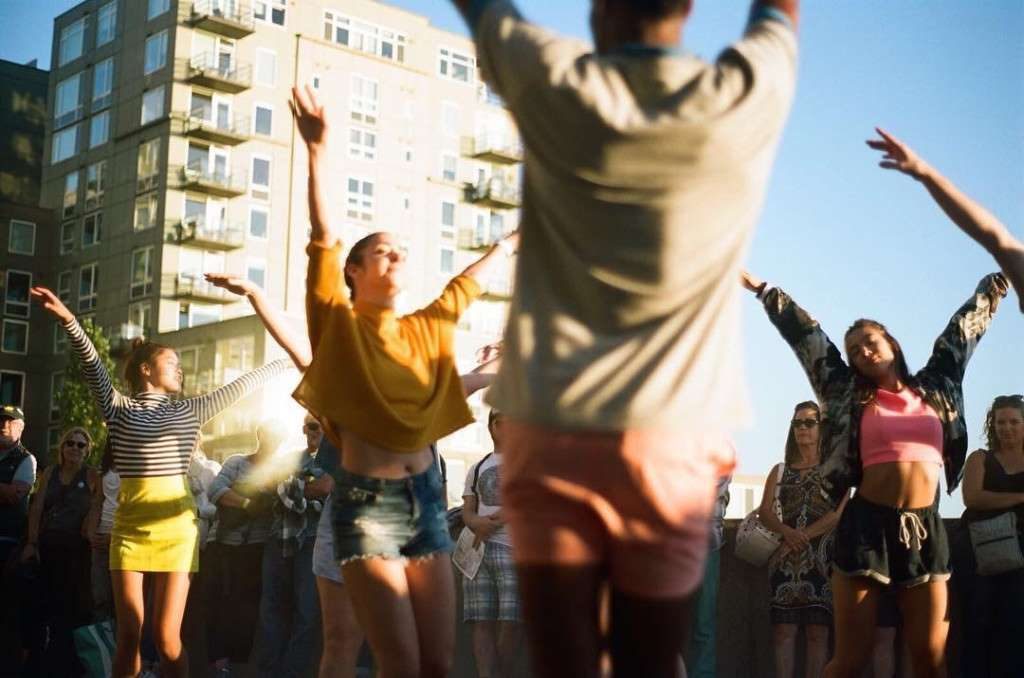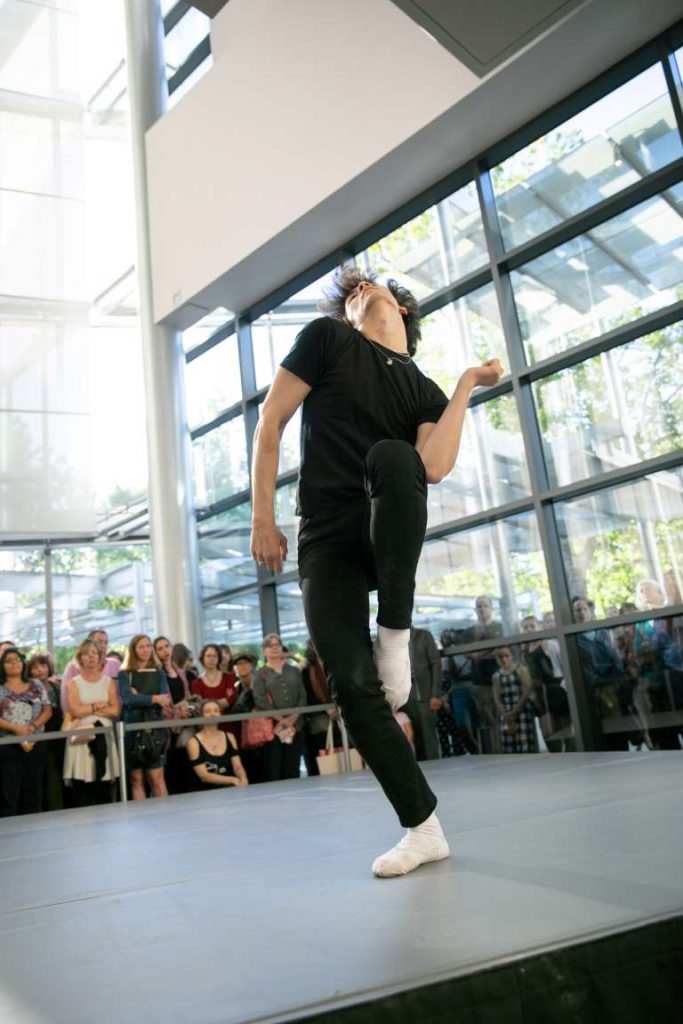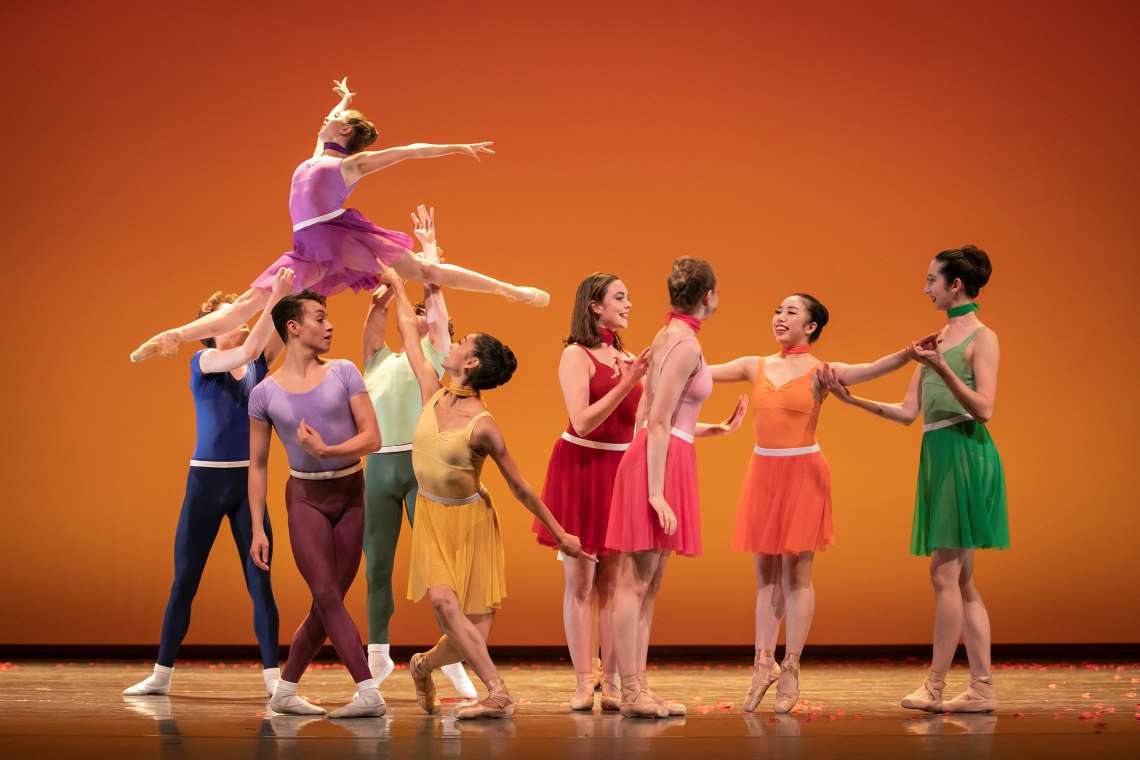Once summer rolls around, nothing can stand between a Seattleite and the outdoors. Which is why the Pacific Northwest Ballet made outdoor performance an annual tradition.
Ask any Pacific Northwest resident what their favorite time of year is and they’ll answer, without hesitation and with a resounding amount of verve, summer. Every workday ends with a detour through the Olympic Sculpture Park or a jaunt around Green Lake. Every weekend is filled with long lazy trips to Golden Gardens or taxing treks in hiking boots. But we’re still art lovers. Just don’t make us go inside.
When it comes to merging a love of the outdoors with a love of art, Pacific Northwest Ballet has you covered. In June 2016, PNB started what will hopefully be a very long tradition of outdoor summer performance, beginning with Sculptured Dance at the Seattle Art Museum’s Olympic Sculpture Park in 2016 and 2017, and continuing on with an annual series of performances on their home turf in 2018 and, now, 2019.
Longtime ballet audiences may remember the first iteration of PNB’s outdoor performance series: summer performances held at Chateau Ste. Michelle from 1992 to 1995. Audiences were charged admission and, as the story goes, there was always a little too much rain. The best part of this new and improved outdoor performance tradition? Admission is free and open to the public.
Peter Boal, artistic director of the Pacific Northwest Ballet, cited access, inclusion and a total removal of entrance barriers as the main reasons these outdoor performances are, and always should be free.
“One of the reasons that we have been interested in outdoor performances of late is to create easier access to ballet,” Boal said. “We had 5,000 attendees at our first Sculptured Dance, many of whom were seeing PNB for the first time. New settings bring new inspiration and new audiences.”

And those new audiences sometimes surprise themselves. Boal recounted the joy he felt whenever an audience member stumbled upon Sculptured Dance or NEXT STEPS: OUTSIDE/IN—as they biked across the Olympic Sculpture Park bike path, played in the Pocket Beach or walked around Seattle Center. It’s a joyous challenge for dancers and choreographers.
“I think both choreographers and dancers love a new canvas,” Boal said. “So much of dance is created in a studio for the stage. A backdrop of sculpture, water or landscape can inspire fresh perspective.”
Boal says there’s a lot to look forward to at this year’s OUTSIDE/IN performance, but the performance he’s most excited about is a group-choreographed piece created for the Kreielsheimer Promenade and Fountain by PNB’s newest and youngest class of choreographers: the nineteen choreographers who make up New Voices: Choreography and Process for Young Women in Dance.
Ron Gatsby, artistic director of Purple Lemonade Collective, first became involved in PNB’s outdoor performance tradition through Purple Lemonade’s partnership with the Seattle Art Museum. When PNB moved their outdoor performances from the Olympic Sculpture Park to Seattle Center in 2018, Gatsby came along for the ride.
With the entire Seattle Center campus available as a canvas, Gatsby chose to choreograph for the International Fountain, using the mythology of Oshun, the Yoruba goddess of art, love, beauty and fresh water as inspiration. When Gatsby is choreographing for indoor performance, they’re conscious of the limitations of the space and how those limitations affect the dynamics of the performance.
“When I’m choreographing for an outside environment,” Gatsby said, “I really allow myself to choreograph movement without concern for the space around me. I can jump higher, reach farther and really stretch myself—both literally and figuratively.”
Gatsby begins every rehearsal for his upcoming NEXT STEPS: OUTSIDE/IN performance with a spoken piece, a story or a meditation on the goddess Oshun. This sets the tone for that day’s rehearsal, preparing the dancers for a new set of choreography or a movement workshop.
“One thing we’ve recently incorporated is rehearsing in Cal Anderson Park in addition to a traditional studio space,” Gatsby said. “This allows us to see how the public organically responds to the movement.”
There are many things you can’t control when it comes to outdoor performance but the biggest outlier is always going to be the weather. Gatsby said that the worst thing a dancer could face when performing outdoors is the possibility of rain. But with the entirety of their piece taking place in the International Fountain, the scariest factor—water—is confronted head on. But that doesn’t make it any less of a challenge.
“The fountain has an effect on everything from the wardrobe to the way we move,” Gatsby said. “Because we are working with the fountain, I have to choreograph movement that is both dynamic and safe enough for the dancers to perform. I have to consider how they’re going to feel dancing in wet clothes, the type of footwear they wear.”
But Ron Gatsby will be the first to tell you: he loves a challenge.

Donald Byrd, artistic director of Spectrum Dance Theater, has been involved in this new tradition of outdoor PNB performance from the very beginning. When Peter Boal invited Byrd to choreograph a piece for the inaugural Sculptured Dance performance in 2016, he was eager to return to site-specific choreography.
“I saw it as an opportunity to return to a kind of work that had given me great pleasure earlier in my career,” Byrd said. “I also thought it would be a lot of fun.”
And it was fun. Byrd enjoyed the challenge of drawing the audience’s attention to the unique outdoor space, especially in the case of Untitled, which was performed at the Roy McMakin sculpture of the same name.
“There is an interplay among the various elements,” Byrd said. “The terrain, sculpture, dancers, movement, audience and sound—including audience sounds; ambient sound like traffic, dogs and sirens; and the predetermined sounds that the choreographer has chosen—all play a role.”
Byrd was incredibly aware of the audience’s role in the performance of Untitled. Because of the dancer’s proximity to the audience, and the audience’s ability to view the performance from any angle, he choreographed the piece as something to be eavesdropped on. It was a breakup.
The biggest challenge in choreographing for Sculptured Dance was being okay with the audience missing part of the performance—either because they were standing too far away or because other audience members were obstructing their view. In the end, it was something Byrd simply had to be at peace with.
“I had to submit to the realness of the circumstances,” Byrd shared.
While Byrd agrees that free public performances like Sculptured Dance and NEXT STEPS: OUTSIDE/IN are important to our community, he warns that “free art” and “accessible art” aren’t synonymous phrases.
“In terms of arts exposure, education and awareness, all of our communities are underserved,” Byrd said. “None of them get enough.”
Which leaves Byrd wondering: How do we get to a point where art plays a critical role in the health and well-being of all our communities? How do we ensure that art becomes essential?
Christopher D’Ariano, a corps de ballet dancer at PNB, first became involved in NEXT STEP: OUTSIDE/IN last year as a participant in both the outdoor and indoor components. As both a dancer and a choreographer in the same 2018 program, D’Ariano performed Donald Byrd’s solo piece Wake the Neighbor and then, mere minutes later, watched a company of PNB Professional Division dancers perform his own choreography: Youthquake. This year, D’Ariano was inspired to create outside the theatre walls.

“Outdoor performances are more unpredictable,” D’Ariano said. “The audience is more involved and the dancers’ work is challenged by the direct gaze of every viewer around them. It becomes a more personal experience.”
The audience’s proximity to the dancers makes everything more intimate. Audience members are granted access into a 360-degree view of the choreography, giving every single moment a new and specific meaning. Audiences share in the sweat, breath and momentum of the piece, sharing in an orchestration of tension and control. And dancers are stripped of the theatrical protections of the orchestra pit, stage lights and curtain.
“Creating for an outdoor space allows me, as a choreographer, room to explore the limits I can push,” D’Ariano shared. “Will the fourth wall be broken, or will the subject be like a fish in an aquarium? The magic lies in the intention.”
Sarah-Gabrielle Ryan, a corps de ballet dancer at PNB, first became involved in the ballet’s outdoor performance tradition as a dancer in Noelani Pantastico’s Picnic at the 2017 Sculptured Dance. The performance was such a success that the entire company was invited back to perform the piece at the 2018 NEXT STEP: OUTSIDE/IN.
“The main adjustment we made to dance outdoors was ditching our pointe shoes for sneakers, which I think we all enjoyed,” Ryan said. “We also had a much closer audience than we get in a theatre. I appreciated this because it allowed us to have a greater connection with our audience than we traditionally do from a raised and distant stage.”
Simply being on the same level as the audience made Ryan feel like she was more than entertainment. She was a human being.
Ryan said the rehearsal process for Picnic wasn’t all that different from a traditional ballet rehearsal. Instead of adjusting for set pieces, Ryan was conscious of the placement of Alexander Calder’s The Eagle or the slope of the Boeing Green.
“We mostly had to make sure the choreography was feasible for grass so that our bodies were protected,” Ryan said.
Ryan loves that PNB includes free outdoor performance as part of their season. “I could seriously do an entire interview on this subject alone,” Ryan joked. When asked to comment on the importance of accessible art in our community, Ryan said this: “Accessible art is essential to all communities—and I love that PNB is contributing to ours.”
This year’s NEXT STEP: OUTSIDE/IN will be held on Friday, June 14 at and around McCaw Hall. The outdoor portion of the performance is free and will be held from 6 p.m. to 7:30 p.m., surrounded by food trucks, a photo booth and PNB giveaways. Choreography by Dammiel Cruz, Christopher d’Ariano, Ron Gatsby, Mark Haim and the nineteen students from New Voices: Choreography and Process for Young Women in Dance will be featured. The indoor portion of the performance is $25 and begins at 7:30 p.m. that evening.
Danielle Mohlman is a nationally produced feminist playwright and arts journalist based in Seattle. Her play Nexus is among the 2015 Honorable Mentions on The Kilroys list. She is an alumnus of the inaugural class of Playwrights’ Arena at Arena Stage and the 2018 Umbrella Project Writers Group.
